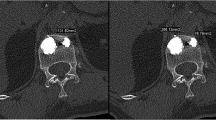Abstract.
Vertebroplasty – percutaneous cement augmentation of vertebral bodies – is an efficient procedure for the treatment of painful vertebral fractures in osteoporosis. At the present time, polymethylmethacrylate (PMMA) is the only available cement with reports of clinical application and experience. The material is easy to handle, the radiopacity can be adapted by adding contrast dye, and it is mechanically efficient. Composite cements (acrylic cements in conjunction with ceramics) are bioactive, highly radiopaque, and feature excellent mechanical properties. One such cement, Cortoss, is currently undergoing clinical trials for vertebroplasty and has so far been shown to be a potentially valuable alternative to PMMA. Several in vitro studies with injectable calcium phosphate (CaP) cements show their feasibility and mechanical effectiveness. Animal studies confirm their biocompatibility and osteoconductivity. However, handling problems and the limited radiopacity of these cements currently preclude their clinical use.
Similar content being viewed by others
Author information
Authors and Affiliations
Additional information
Electronic Publication
Rights and permissions
About this article
Cite this article
Heini, .P., Berlemann, .U. Bone substitutes in vertebroplasty. Eur Spine J 10 (Suppl 2), S205–S213 (2001). https://doi.org/10.1007/s005860100308
Received:
Accepted:
Issue Date:
DOI: https://doi.org/10.1007/s005860100308




